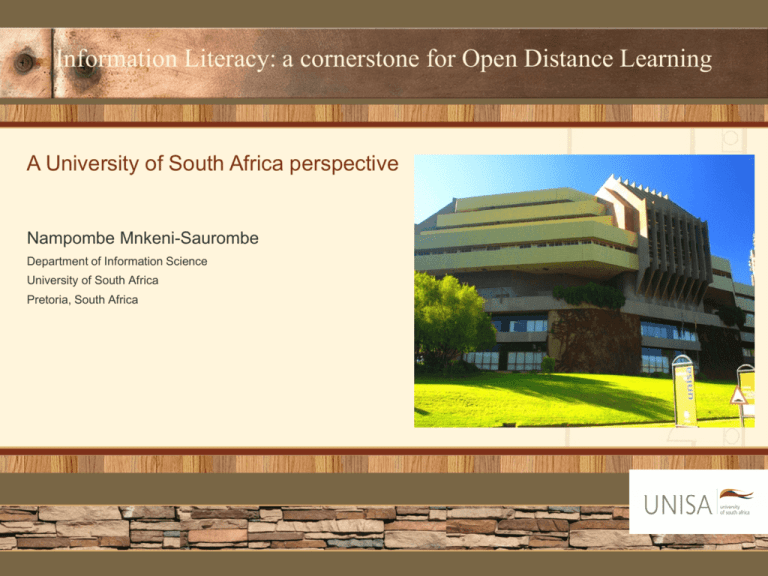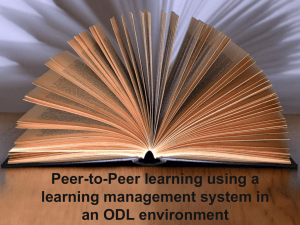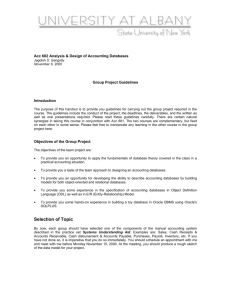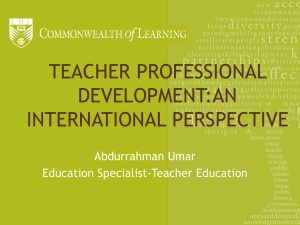Information Literacy: a cornerstone for Open Distance Learning
advertisement

Information Literacy: a cornerstone for Open Distance Learning A University of South Africa perspective Nampombe Mnkeni-Saurombe Department of Information Science University of South Africa Pretoria, South Africa Delete text and place photo here. University of South Africa Place a photo of a home you are selling here Dates back to 1873 Unisa library is an 8 floor Distance education building equipped for tuition and curriculum began in 1946 research 6 Colleges: Economic and 8 library branches countrywide Management Sciences, Human Strives to train clients in basic Sciences, Law, Science, and advanced research skills. Continue PowerPoint text. Continue Engineering and Technology, Education & Agriculture and PowerPoint text. Continue PowerPoint Environmental Sciences Delete text and 7 Regional centres in PowerPoint text. Continue text. Continue place photo here. Eastern Cape, Western Cape, PowerPoint text. Continue PowerPoint Limpopo, Midlands, Gauteng and Mpumalanga text.students Continue PowerPoint text. Continue 287,142 5016 Academic Staff Subhead PowerPoint text. Outline 1. Purpose of the study 2. Open distance learning 3. Information literacy in an ODL context 4. Information literacy- the status quo 5. Information literacy training at Unisa 6. What can be done? 7. Recommendations 8. Conclusion Purpose of the study 1.Identify the need to boost information literacy training at Unisa. 2.Outline challenges encountered with regard to information literacy training at Unisa. 3.Recommend means for ODL librarians to improve information literacy training at Unisa or other ODL institutions. Open Distance Learning A multidimensional approach aimed at bridging the time, geographical, economic, social, educational and communication distance between student and institution, student and academics, student and courseware and student and peers. Open distance learning focuses on removing barriers to access learning, flexibility of learning provision, student centeredness, supporting students and constructing learning programmes with the expectation that students can succeed. (Unisa ODL Policy, 2008) InformationInformation Literacy in an ODL context Literacy (Library Next, 2008) Information Literacy in an ODL context Independent students are successful students. ~ Prof H. Ngambi (Executive Dean CEMS) Information literacy is a key competency for independent study, the self- directed learner, life long learning and the foundation of a literate society. Therefore important for student achievement. (Sacchanand, 2002:3) Librarians in ODL settings should actively contribute to information literacy instruction Library instruction and Information literacy modules 1. 2. 3. 4. 5. 6. 7. 8. Library orientation Basic library skills Advanced library skills Computer literacy Internet ( basic and advanced) Library catalogue (Oasis) Electronic subject databases Induction (Unisa IL guidelines, 2006) IL training is mostly conducted at the Electronic Learning Centre at the Unisa library at the Main campus and at the branch libraries The Status Quo: a personal experience 3rd year modules in the B. Information Science degree programme : INS3059- Knowledge and Information Management and INS3036- Using information: the role of information behaviour. Tutorial letter INKALLE/302- Guides students on how to understand their projects, research a topic, write an assignment, and technical details. INS1502- Developing information skills for life long learning, is a compulsory 1st year module for B. Inf. students. The Status Quo: a personal experience contd. 30- 40% of students: Fail to provide detailed explanations/discussions/ sound arguments. Plagiarize Fail to understand assignment topics Only use their study guide as a source of information for their assignment projects Information literacy training survey at Unisa Library •Client Division Services is responsible for IL training. Unisa has IL guidelines and not an IL policy. • Personal librarians and branch librarians at Unisa conduct IL training for students and academic staff. •Personal librarians are based at Unisa Main Campus Library •Personal Librarians web survey to describe IL training at Unisa • There are 19 PLs, 10 responded yielding a 52 % response rate. Findings Qualifications of participants Extent of IL training courses Participants of IL courses IL Courses Assessment of IL courses PhD 1 B.Inf. Hons 2 B. Bibl Hons. 3 B. Inf. 1 M. Inf. 2 MA 1 •83 % indicated that IL training is an important aspect of ODL. • 75 % stated that they teach academics and postgraduate students • Mode of learning: face to face classes, one on one tuition, computer based training resources (myUnisa), mobile devices and printed or self – guided brochure • 66.7 % pre- assess client needs via surveys, focus groups, academic feedback and problem analysis • 100%conduct evaluation after courses using questionnaires. • Information is used to adapt or improve future programmes, identify trainer needs, demonstrate value and get funding • 50% pointed out that 25- 50 % of their work load is committed to IL training. •66.7 % agreed that IL programmes are integrated with Unisa’s ODL policy Findings contd. Trainer needs & keeping up to date on IL trends Challenges and opportunities identified by PLs in the web survey Challenges identified from literature • Only one individual responded to this section. •No challenges • This individual subscribes to an online discussion forum, reads some IL literature and attends conferences on IL. • 2 individuals (11%) indicated that they are sufficiently equipped with the right skills and resources to conduct IL courses at Unisa. •Library staff perceptions and attitudes •Inadequate resources for training large groups •Remote students and inadequate online training materials •More emphasis on walkins and not other students •Disadvantaged clients with no access to computers •Cultural diversity •Differing levels of IL and computer literacy ( Bopape & Constable, 2011; Brown & Mokgele, 2007) •Lack of policy/guidelines on Web 2.0 tools • Insufficient marketing • inadequate collaboration with academic staff. • inaccessibility to certain databases when off Unisa campuses Factors that can affect IL training in an ODL institution Adapted from Bent, 2008. What can be done? Embedded librarianship is part of an overall strategy to provide “equivalent” library access, resources and services for distance students (Hoffman 2011) The embedded online librarian is a librarian that participates in a particular online course by logging into the course management system. Embedded librarian services are established to provide online instruction and develop student research skills. It is a collaborative effort between academics and the librarians. Discipline based Information literacy: Daly (2010) reports on their embedded librarianship venture that involved including librarian contact details, and resources linked to course sites. The results were that students benefited from more personalised research guidance and more course success. Recommendations •Effective IL training programmes in an ODL environment require constant research. •ODL librarians should not forget that they are life long learners too. • Improve collaboration between librarians and academic staff. •Take advantage of learning management systems e.g. myUnisa to improve IL integration within the ODL curriculum •Set a clear IL policy that will guide IL practices at the institution. Recommendations •Effective IL training programmes in an ODL environment require constant research. •ODL librarians should not forget that they are life long learners too. • Improve collaboration between librarians and academic staff. •Take advantage of learning management systems e.g. myUnisa to improve IL integration within the ODL curriculum •Set a clear IL policy that will guide IL practices at the institution. Recommendations •Effective IL training programmes in an ODL environment require constant research. •ODL librarians should not forget that they are life long learners too. • Improve collaboration between librarians and academic staff. •Take advantage of learning management systems e.g. myUnisa to improve IL integration within the ODL curriculum •Set a clear IL policy that will guide IL practices at the institution. Recommendations •Effective IL training programmes in an ODL environment require constant research. • Improve collaboration between librarians and academic staff. •Take advantage of learning management systems e.g. myUnisa to improve IL integration within the ODL curriculum •Set a clear IL policy that will guide IL practices at the institution. Recommendations •Effective IL training programmes in an ODL environment require constant research. •ODL librarians should not forget that they are life long learners too. • Improve collaboration between librarians and academic staff. •Take advantage of learning management systems e.g. myUnisa to improve IL integration within the ODL curriculum •Set a clear IL policy that will guide IL practices at the institution. Conclusion Information literacy remains a crucial part of ensuring student success and developing lifelong learners at Unisa and other ODL institutions. As the ODL delivery mode landscape progresses, librarians should therefore seek ways to develop themselves as IL trainers and strive to implement suitable IL programmes for students and academics. Thank you Thank you! Contact details: Nampombe Mnkeni-Saurombe Department of information Science University of South Africa Pretoria Email: mnkennp@unisa.ac.za




